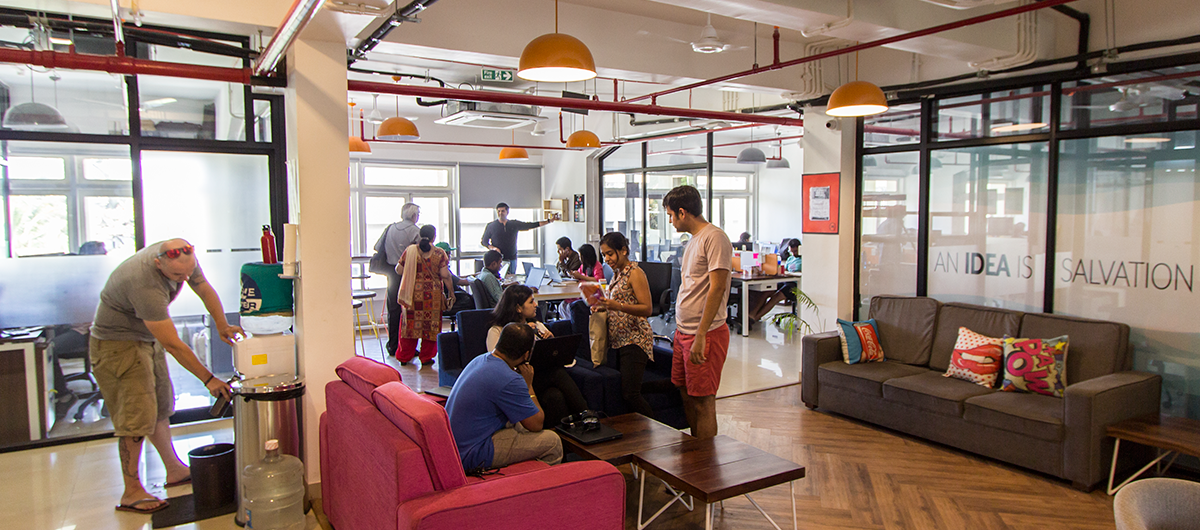Break-even point reached in twelve months
On average, coworking spaces break even within twelve months, one month earlier than in the last survey. It’s a little faster in cities with more than a million inhabitants. Spaces reach the break-even point even faster if they do not rent their locations, but instead manage them for the landlord or market them to large-scale customers. However, coworking spaces that target individual customers also generally reach the break-even point within a year.
It takes longer in medium-sized coworking spaces, in medium-sized cities or if the space has a strong focus on small companies with up to 10 employees. All of these characteristics may of course overlap.
Profitable coworking spaces achieve the highest margins when they are small!
This was the first time we conducted a survey on annual profit margins. For this, we only considered coworking spaces which report a profit, excluding unprofitable and ‘zero-profit-zero-loss’ spaces. In this case, we found that small coworking spaces achieve the highest profit margins!
Downsizing would mean little to those hoping to make substantial profits. The margins represent relative values. The absolute profit is all the smaller if you have particularly high margins. Among them are more coworking spaces that are not dependent on profits from their operation. Many of them are probably renting out freely available space as lucrative additional business without substantially increasing their fixed costs. Since unprofitable spaces are missing from the analysis, supposedly unfavorable features such as minimal space or a small number of members no longer have the same negative impact on the profit.
In general, profitable coworking spaces achieve an annual margin of 17%* on average. With anomalies at both ends taken into account, this figure rises to 19%. For business models that are large and self-sustaining, an average margin of around 15% is more realistic.
If you exclude the very small coworking spaces, the margin increases very slightly as the number of members increases. There is no similar correlation when it comes to an increase in area. This is probably because the costs per square meter increase more than per member.
However, other conditions show a positive connection.Coworking spaces can achieve above-average profit margins if they operate several locations, own the properties themselves or manage their coworking spaces for the owners under a management agreement.
Margins for non-existent or very high monthly churn rates are unexpectedly high at first glance. They again represent particularly small coworking spaces.
The low profit margins of coworking spaces that have been operating for more than five years comes as a surprise. They sit at 14%, whereas they rise to 20% for younger spaces as the age increases.
Equally surprising, those offering 'low prices' generate the highest annual margins (20%) on average when comparing the profitable coworking spaces by their unique selling points. Missing an 'enjoyable working atmosphere' in this comparison of USPs drops the margin the most. Keep in mind, a single factor doesn’t necessarily cause this situation.
Unprofitable coworking spaces do not generally offer cheaper prices
The Global Coworking Survey also measured the absolute monthly revenue and expenses that result in profits and losses. However, the results only represent a short period of time***. Due to monthly fluctuations, they do not serve as projections for an entire year. For example, expenses such as annual taxes may be missing because they do not occur every month. Nevertheless, we can still draw some conclusions from the figures.
The reason why unprofitable coworking spaces make a loss is not because they offer cheaper prices, since their revenue per member****, is actually at the level of profitable coworking spaces. In the USA, this is about US$235*; in the eurozone, it is about €220* per month.
It is only as we consider the expenses per member that they begin to diverge. Unsurprisingly, the expenses for unprofitable spaces are considerably higher than the revenue they generate, while the expenses for profitable spaces are significantly less. One reason for this is simply that unprofitable coworking spaces have a lower occupancy rate. The revenue per square meter points to the same reality: unprofitable coworking spaces generate significantly less than profitable ones.
At least in the USA, we can see that their expenses per square foot are also higher. In other words, the low occupancy rate is not the only reason for the economic inefficiency. If further high losses***** were removed from the analysis, the same would apply to the eurozone.
Many coworking spaces do not need to make a profit!
Every third coworking space across the world is a special type that reports neither profits nor losses. Their share is likely to remain high in the future, as many say they are not very dependent on making a profit when renting out workspaces. However, there are also younger coworking spaces among them that tend to generate positive business figures.
'Zero-profit-zero-loss' coworking spaces are rather small, often target individual memberships, are operated more frequently on the side and mainly generate income from direct desk rental rather than private offices. Accordingly, they often have a more open design.
Their revenue per member is significantly lower than that of profitable and unprofitable coworking spaces. Relatively, they are more often found outside the megacities. Their occupancy rate is about average, usually filling all workstations. Unlike profitable coworking spaces, however, these workstations are rarely rented out more than once during the same period.
The most important results on this topic from the Global Coworking Survey have been summarized in tables. You can download them here free of charge. A complete graphic analysis can be found here.
:::
The 2019 Global Coworking Survey is officially supported by the following organizations:
Main Supporters:
Nexudus Spaces - a management tool for coworking spaces
Essensys - a management tool for coworking spacess
Yardi - a management tool for coworking spaces
Distribution partners:
CoworkingResources - a consultancy tool for coworking spaces
Included.co - a platform to provide business-boosting perks to coworking spaces & their members
IndyHall - a coworking space in Philadelphia
Regional partners:
GCUC North America, Coworking Europe Europe
CUASIA Asia, Qdesq India
Coworking Content North America, Cobot worldwide
Official Supporters:
Coworking Switzerland,
German Coworking Federation,
Sneed India, TopCoworks India,
Office RnD UK/USA/Bulgaria/New Zealand,
No Office Work Portugal, Kisi USA/Germany,
ImpactHub Taipei, Pickspace Israel
SpaceCubed Australia, LeadSpace Nigeria,
AgoraRDM USA, Coworking Croatia
Satellite DeskWorks USA, Hubud Indonesia,
St. Oberholz Germany, Amp Canada
Wexelwirken Germany, WellCoworking Italy
GorillaSpace Singapore, LottoCinque Italy
Coworking Frauenfeld Switzerland,
Coworking Library Germany/USA,
Business Link Poland.
Here, you can read more about the 2019 Global Coworking Survey.
:::
Footnotes:
* 5% trimmed mean
** More than 50 members or larger than 250 square meters
*** The figures represent one of the following months: December 2018, January 2019 or February 2019.
**** The values do not correspond to the price for individual memberships, as they may include volume discounts, free months or additional services.
***** Losses of more than 5,000 euros per month







